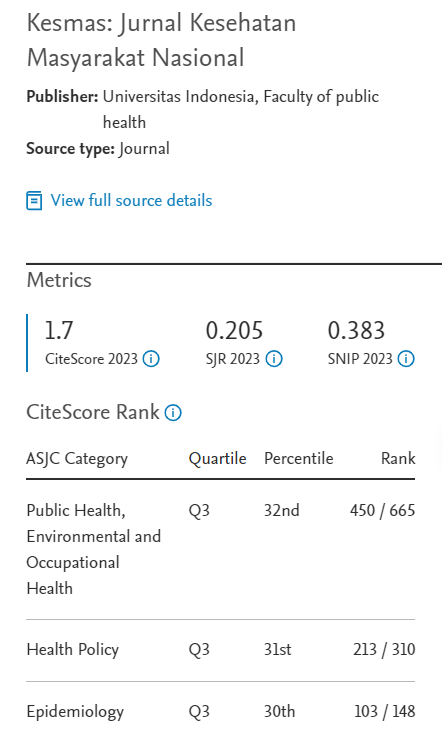Abstract
Gangguan tidur dapat dialami oleh setiap orang tanpa mengenal status sosial dan pendidikan. Diperkirakan setiap tahun terdapat 20% – 40% orang dewasa mengalami gangguan tidur dan 17% diantaranya mengalami masalah serius. Penelitian ini bertujuan untuk mengetahui hubungan antara penerapan pergantian waktu kerja (shift) serta beberapa faktor lain terhadap pola tidur pekerja di bagian produksi sebuah PT Enka Parahiyangan tahun 2008. Hasil penelitian menunjukkan bahwa kejadian pola tidur kurang baik pada kelompok pekerja shift (67,1%) lebih tinggi daripada non-shift (32,9%). Selain itu, didapatkan odds ratio pola tidur pada pekerja shift 7,1 kali jauh lebih tinggi dibandingkan dengan non-shift. Faktor konsumsi kafein dan penggunaan obat tidur terbukti dapat memengaruhi pola tidur dan keduanya terbukti sebagai perancu. Disimpulkan bahwa penerapan shift (pagi, sore, malam) dapat menyebabkan kejadian pola tidur kurang baik lebih tinggi daripada non-shift sehingga perlu dilakukan peninjauan kembali penerapan rotasi shift oleh perusahaan. Pekerja disarankan agar menjaga jadwal tidur, menghindari konsumsi minuman berkafein, serta menggunakan obat tidur.
Sleeping disorder could be experiended by everyone without seeing social and education status. Approximately there 20% -40% adults with sleeping disorder per year, 17% of it having serious problems. This study was aimed to explain relationship between working-shift (shift and non-shift) implementation and workers’ sleeping pattern at the production department of a company PT Enka Parahiyangan in the year 2008. The result showed that shift workers that experienced bad sleeping pattern (67,1%) more than non shift workers (32,9%). The risk to odds ratio (OR) of experience bad sleeping pattern were higher among shift workers increased by 7,1 times more than non-shift workers. Caffein and sleeping drug consumption were found influencing sleeping pattern as well as being confounding factors. This study concluded that implemenation of working shift (day, evening, night) affect sleeping pattern negatively among shift workers. It is recommended that to review working shift rotation, advice workers to maintain sleeping schedule, and avoid taking caffein and sleeping drug.
References
- Prayitno A. Gangguan pola tidur pada kelompok usia lanjut dan penatalaksanaannya. Jurnal Kedokteran Trisakti. 2002; 21 (1): 23-30.
- Japardi I. Gangguan tidur. Sumatera Utara: Fakultas Kedokteran Bagian Bedah Universitas Sumatera Utara, USU Digital Library; 2002.
- National Sleep Foundation. Strategies for shift worker: the night shift worker and sleep. 2005 [cited 2008 April 23]. Available from: http://www.sleepfoundation.org/site/c.hulXKjM0IxF/b.2421189/k.DF93/strategies_for_sif_worker.htm.
- Klein D. Sleeping on the job. Canberra Times. 2004 [cited 2008 April 23]. Available from: http://www.sleepdex.org/b4.htm.
- Kuswadji S. Pengaturan tidur pekerja shift. Cermin Dunia Kedokteran. 1997; (116).
- Maurice. Prevalence and consequences of sleep disorders in a shift worker population (abstract). Journal of Psychosomatic Research. 2007 [cited 2008 April 23]; 53. Available from: http://www.cat.inist.fr/ ?aModele=afficheN&cpsidt=13856210.
- Pheasant S. Ergonomic, work, and health. Maryland, United States of America: Aspen Publisher. Inc. Gaithersburg; 1991.
- Garbarino S. Sleepiness and sleep disorder in shift workers: a study on a group of Italian police officers. Sleep. 2002; 25 (6).
- Amran Y, Iting S, Puti N. Hubungan penerapan shift kerja dengan kelelahan kerja. Proceedings of The National Conference on Applied Ergonomics. 2010; Universitas Gadjah Mada, Yogyakarta.
- International Labour Organization. Encyclopedia of occupational health and safety. In: Stellman, Jeanne M, editors. Volume 1 – 4, 4th edition. Geneva, Switzerland; 1998.
- Colligan, Michael J, Roger RR. Plain language about shift work. Cincinnati, Ohio: Department of Health and Human Service, National Institute for Occupational Safety and Health; 1997.
- Grandjean E. Fitting the task to the man. 4th edition. London: Taylor and Francis Inc; 1993.
- Rosmaliana. Tinjauan keluhan gangguan pola tidur pada pekerja shift di PT Bridgestone Indonesia tahun 2004 [skripsi]. Depok: Fakultas Kesehatan Masyarakat Universitas Indonesia; 2004.
- Noor A. Mengatasi insomnia. Banjarmasin Post. 2003 [cited 2008 April 23]. Available from: http://www.Indomedia.com/bpost/052007/21/ ragam/art-1.htm.
Recommended Citation
Amran Y , Handayani P .
Hubungan Pergantian Waktu Kerja dengan Pola Tidur Pekerja.
Kesmas.
2012;
6(4):
-
DOI: 10.21109/kesmas.v6i4.92
Available at:
https://scholarhub.ui.ac.id/kesmas/vol6/iss4/2







